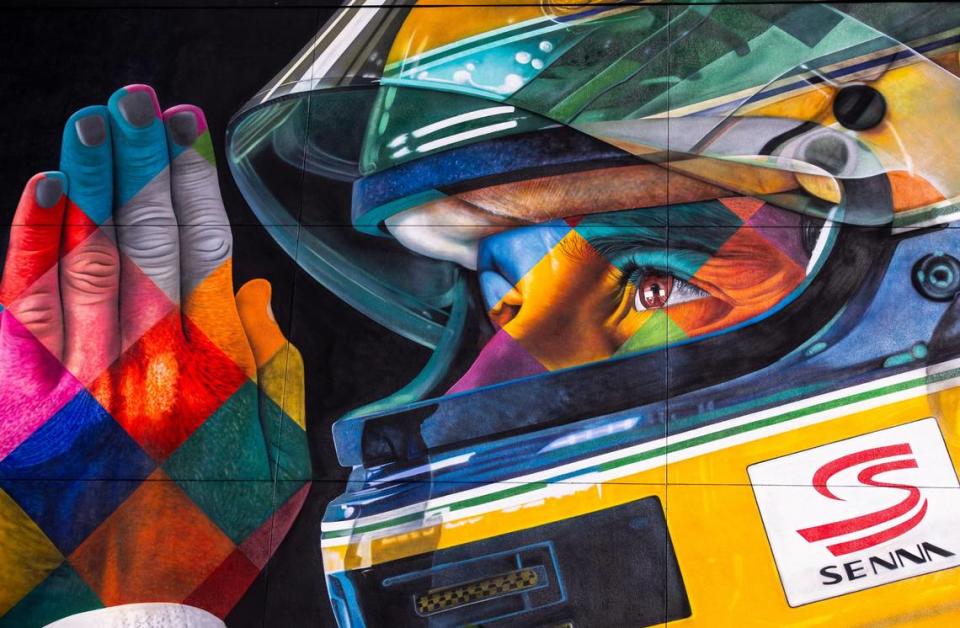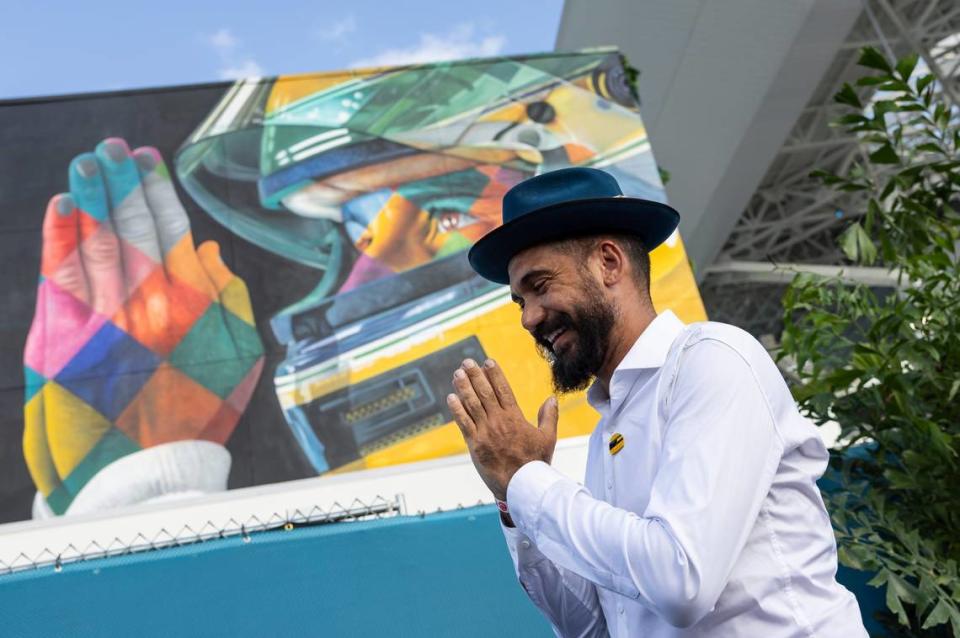A Brazilian artist’s mural of F1 icon Ayrton Senna unveiled at the Miami Grand Prix track
Brazilian Eduardo Kobra was 19, and already a veteran street artist when countryman and three-time Formula 1 world champion Ayrton Senna crashed and died at Imola in 1994. Thirty years and a day later, Kobra revealed his latest tribute to Senna, a mural that graces a side of the Crypto.com Miami Grand Prix race control building.
“Throughout my career as an urban artist, I have had the privilege of painting murals in various parts of the world, some of them depicting Senna,” Kobra said through an interpreter Thursday. “But, few projects have meant as much to me as this one.
“Ayrton Senna was not only a champion on the track, but an inspiration to millions of people around the globe. His legacy transcends sport and continues to impact generations. It is an honor to be able to contribute to preserving his memory in such a significant way.”
READ MORE: Formula 1 ace Ayrton Senna died 30 years ago. The Miami Grand Prix honors him this week
The mural features Senna in his yellow helmet, arguably the most recognizable racing headwear ever, with multicolored diamonds forming a transparent sheet over his hands and face. The hands of a man who wasn’t loud about his spiritual beliefs, but wasn’t shy about them either are pressed together in the manner of prayer.

“I hope to convey his energy in life and in sport,” Kobra said.
Dolphins president and Miami Grand Prix managing partner Tom Garfinkel said he has had a piece done by Kobra in his office for years, but it was the artist who reached out to race organizers about celebrating Senna.
In addition to the mural, artwork from Kobra’s 18-canvas exhibition “Ayrton Senna: 30 Years of Missing” decorates the Paddock Club.

READ MORE: ‘It’s now a sport here.’ The Formula 1 circus is back in Miami Gardens
The 5 most shocking on-track deaths of Formula 1 drivers
In alphabetical order.
▪ Jim Clark, April 7, 1968. Like Senna, Clark once held the F1 record for pole positions, and is still considered by some to be the best ever. Unlike Senna, who had physical run-ins with rivals Alain Prost and Nigel Mansell on and off the track, Clark never seemed out of control even when in a spin. Clark won the 1963 and 1965 F1 world titles, as well as the 1965 Indianapolis 500. After testing the turbine-powered car designed by Lotus’ Colin Chapman, Clark felt sure he would win Indy again in 1968. Mechanical failure sent Clark’s car into a tree during a Formula 2 race at Hockenheim, Germany. Chris Amon wasn’t the only driver to murmur a variation on “if that could happen to him...”
▪ Jochen Rindt, Sept. 5, 1970. How omnipresent in racing was death’s threat? A world champion won his title posthumously after being the third F1 driver to die in a crash that season (Bruce McLaren driving Can-Am, Piers Courage). Rindt raced in F1 for five seasons before joining Team Lotus in 1969. That year, he got his first win and won five of the first eight 1970 races. He still led the driver points going into the 10th race, at Monza. Mechanical failure and bad safety barriers combined for a fatal practice crash. Despite Rindt’s death with four races left, Jacky Ickx couldn’t close the gap.
▪ Aryton Senna, May 1, 1994. Senna, the 1988, 1990 and 1991 world champion, moved from McLaren to Williams, the dominant team in 1992 and 1993. Expected to lay waste to the field, the Senna-Williams combination seemed almost cursed with multiple problems every week before the San Marino Grand Prix. Senna qualified on pole, but on the seventh lap, his Williams didn’t even start to make the hard left at Imola’s Tamburello corner. Blame has been placed on the steering column. Senna smashed into the concrete wall. He died later that day.
▪ Wolfgang Von Trips, Sept. 10, 1961, and Ronnie Peterson, Sept. 10, 1978. Always and forever linked. Each entered a late-season race at Monza as the only threat to an American teammate, Ferrari’s Phil Hill in 1961 and Lotus’ Mario Andretti in 1978. Von Trips led Hill by four points and qualified on pole at Monza. But when Clark and Von Trips collided on the second lap, Von Trips car crashed into a crowd of fans as he got thrown from the car and bounced off the track. Von Trips and 14 fans died. Phil Hill won the race. Ironically, his win meant Ferrari saw no reason to cross the Atlantic and give Hill the chance to close the season driving his home the U.S. Grand Prix.
Peterson was second in the points to Andretti. In a disorganized start with Riccardo Patrese still rolling, Patrese stunned James Hunt, who reacted and clipped Peterson. Peterson smashed head-on into a barrier while several other cars crashed behind him. During surgery on his destroyed legs, Peterson developed blood clots and died the next day. Andretti, who emigrated from Italy at 15 but always raced as an American, joined Hill as the only F1 world champions from the United States.

